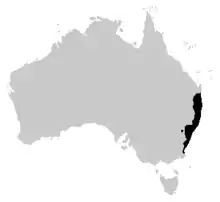Robust bleating tree frog
The robust bleating tree frog (Litoria dentata), also known as Keferstein's tree frog, is a species of tree frog in the subfamily Pelodryadinae. This frog is endemic to coastal eastern Australia, where it ranges from northeastern New South Wales to the NSW/Queensland border. It has also been introduced to Lord Howe Island.[1][2]
| Robust bleating tree frog | |
|---|---|
| Scientific classification | |
| Domain: | Eukaryota |
| Kingdom: | Animalia |
| Phylum: | Chordata |
| Class: | Amphibia |
| Order: | Anura |
| Family: | Hylidae |
| Genus: | Litoria |
| Species: | L. dentata |
| Binomial name | |
| Litoria dentata (Keferstein, 1868) | |
 | |
| Distribution of the bleating tree frog, including L. balatus and L. quiritatus | |
| Synonyms | |
| |
Taxonomy
Prior to 2021, this species was thought to have a much wider range, from northeastern Victoria to southern Queensland, and was simply known as the bleating tree frog. However, Rowley et al (2021) distinguished three distinct clades within the species, based on genetic divergence, slight morphological differences, and notable differences in vocalizations; the latter were collected via the FrogID Australia citizen science project. Two new species were described from north and south of L. dentata's range: the slender bleating tree frog (L. balatus) to the north and the screaming tree frog (L. quiritatus) to the south. This significantly reduced the known range for L. dentata, although it is known to still be a common and adaptable species.[3][4][5]
Description
This species can be distinguished from the two species split off from it by its more robust build compared to L. balatus and a brownish vocal sac that turns dull yellow when fully inflated.[6]
Ecology and behaviour
This frog is associated with coastal lagoons, ponds and swamps, in heathland, sclerophyll forest and cleared farmland. The bleating tree frog is well known for its loud, high-pitched call, which can be painful to humans nearby. Males call from vegetation or ground around the breeding site. Mass breeding and calling can take place on warm, wet, overcast nights during spring and summer.
As a pet
It is kept as a pet, in Australia this animal may be kept in captivity with the appropriate permit.
References
- Hero; et al. (2004). "Litoria dentata". The IUCN Red List of Threatened Species. IUCN. 2004: e.T12146A3326253. doi:10.2305/IUCN.UK.2004.RLTS.T12146A3326253.en. Retrieved 9 January 2018. Database entry includes a range map and a brief justification of why this species is of least concern
- Article Road: List of All Frog Breeds: Things You Can Do to Ensure Your Frog Has a Long, Happy and Healthy Life: Bleating Tree Frog
- Department of Environment, Climate Change and Water, New South Wales: Amphibian Keeper's Licence: Species Lists
- Cogger, H.G. 1979. Reptiles & Amphibians of Australia. A. H. & A. W. REED PTY LTD. ISBN 0-589-50108-9
- Anstis, M. 2002. Tadpoles of South-eastern Australia. Reed New Holland: Sydney.
- Robinson, M. 2002. A Field Guide to Frogs of Australia. Australian Museum/Reed New Holland: Sydney.
- Frogs Australia Network-frog call available here.
- "Litoria dentata (Keferstein, 1868)". Amphibian Species of the World.
- Rowley, J. J. L.; Mahony, M. J.; Hines, H. B.; Myers, S.; Price, L. C.; Shea, G. M.; Donnellan, S. C. (2021-11-22). "Two new frog species from the Litoria rubella species group from eastern Australia". Zootaxa. 5071 (1): 1–41. doi:10.11646/zootaxa.5071.1.1. ISSN 1175-5334.
- z3440238 (2021-11-23). "Surprise discovery of two new 'very loud' frog species". UNSW Newsroom. Retrieved 2023-08-07.
- "Two new 'loud' frog species have been found along the east coast of Australia". Australian Geographic. 2021-11-23. Retrieved 2023-08-07.
- "Two New Species of Tree Frogs Discovered in Australia | Sci.News". Sci.News: Breaking Science News. 2021-11-22. Retrieved 2023-08-07.
- Rowley, Jodi (22 November 2021). "Bleating or screaming? Two new, very loud, frog species described in eastern Australia". The Australian Museum. Retrieved 2023-08-07.
